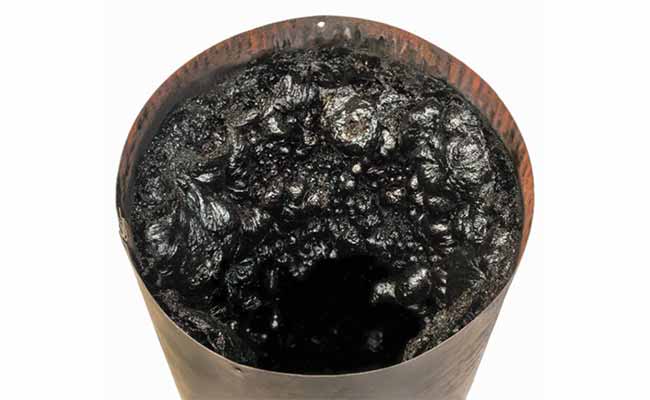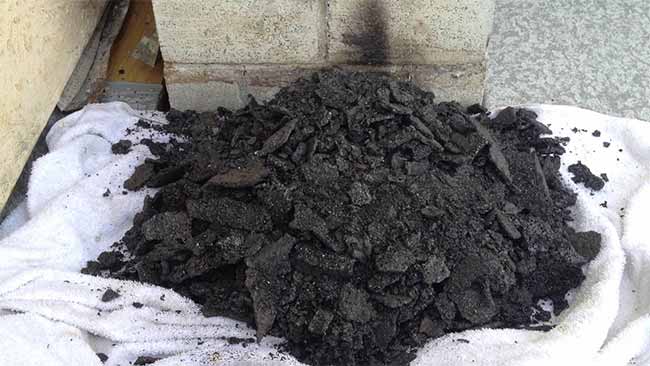Creosote is one of the undesirable byproducts that might result from the burning of firewood. Creosote production is frequently minimized by burning low moisture content wood, while it can be found in much higher proportions when the wood is not completely combusted.
Creosote can have both short and long-term effects on fireplaces and chimneys where it is allowed to build up. In this article, we will learn about creosote buildup, its stages, and how to remove and prevent it.

Burning wood or fossil fuel does not always burn properly in insufficient airflow. If the wood or fossil fuel is not burned, inflammable smoke will rise. As the smoke rises, it cools and condenses inside the chimney, where it is mixed with water and other things that travel through the fuel. That compound is known as creosote. It is a colorless to yellowish greasy fluid with a pronounced burnt flavor and a smoky odor. Creosote comes in three different levels of danger.
When wood is not burnt correctly and creosote forms, heated air flowing up a chimney causes creosote to build up. Creosote cools and solidifies on the chimney liner as it goes up. Creosote buildup is low in any regular wood-burning fire. But if more creosote is created than usual due to recurring poorly burning flames, the creosote can form into thicker layers and cause more serious issues.

To prevent creosote from developing long-term problems with your fireplace, it is essential to understand how creosote is created and why it gets within a chimney or flue.
The following are the most common reasons for creosote buildup in a chimney:
This can be the result of a fire struggling because of incomplete combustion, which can also be caused by a problem with the wood or insufficient air supply. Unfinished combustion of firewood that creates creosote is the cause of a lack of air supply during the burning.
A chimney with a lower temperature is another reason for the causes of creosote. Cooler areas within a chimney or flue can cause creosote to evaporate and build on the sides.
If the creosote is already lining a chimney or flue, the air may be affected due to a decreased diameter gap. As air rises, it may become stuck or lose velocity, which is another reason for producing more creosote.

There are three stages of the buildup of creosote. All of the stages are dangerous for human health. It is better to know about all the stages so that you can take proper steps to get rid of them before any accident happens.
Here are the stages of the buildup of creosote:
Stage 1
Stage 1, also known as First Degree Buildup, is most usually found in the form of soot, which is the simplest form of buildup to remove. You can typically remove it as part of your regular chimney cleaning using a brush. It is normal to see minor amounts of creosote build up in your chimney when you have clean-burning fires with dry wood throughout the year.
Stage 2
Insufficient air supply or burning wet wood causes larger layers of creosote to gather within your chimney. When the amount of creosote is high, it is known as stage 2. Stage 2 creosote is more difficult to remove. It has the appearance of black tar-like flakes and is more likely to start chimney fires. The usage of more specialist tools may be required for this Second Degree Buildup. It is more dangerous than stage 1.
Stage 3
Extremely poor burning conditions are the result of a dense layer of thick, tar-like creosote lining in a chimney. This produced synthetically creosote coating is far more difficult to remove.
It can be formed by the inadequate combustion of wood produced by burning wood that is high in moisture. It happens due to the earlier buildup of creosote which creates restrictions to the ventilation of the fires. Stage 3 is the most dangerous and has the highest risk of creating chimney fires.

Now you may ask why you should care about creosote buildup. The answer is here to clear all your confusion regarding creosote. Creosote can do significant harm to your chimney when it accumulates. While each stage poses its own set of dangers, any amount of creosote is dangerous.
Here are a few reasons why you should care about creosote buildup:

To remove the buildup of creosote, have your chimney cleaned by a professional as soon as possible. The cleaning process of creosote depends on the stage of the creosote. If you follow the proper method, you can remove them easily.
It is pretty simple to remove stage 1. All you need is to use a chimney brush to remove the creosote. If you remove it regularly, it will be easier for you.
Step-by-step process of removing stage 1:
Step 1: Take a chimney brush.
Step 2: Scrub the brush to remove the creosote in the chimney.
Step 3: Repeat the process until all the creosote is removed.
Simple brushing methods may not be enough for Stage 2 buildup of creosote as it is harder and stickier than Stage 1 creosote. You will need more specialized tools known as rotary tools to remove the creosote buildup.
Steps by step process of removing stage 2:
Step 1: Take a brush and scrub the creosote in the chimney so that you can remove some of it.
Step 2: After this, take the rotary tool, which contains metal rods that move quickly and break the creosote off from the liner or chimney
Step 3: Continue the process until no creosote remains.
At this point, creosote is most dangerous, and it is flammable. It is usually used as fuel for a chimney fire. Although stage 3 creosote can be removed using a special tool in some cases, the procedure can damage clay or ceramic chimney liners. As a result, most chimney experts advise that if stage 3 creosote is found, the chimney liner should be completely replaced.
Steps by step process of removing stage 3:
There is no specific step to follow. Try the rotary tool first. If it doesn't work, replace the chimney liner. If it is in stage 3, then take advice from the experts and take steps accordingly.
To get a clear idea about removing Creosote buildup, Watch this video
Knowing how creosote is produced and why it builds can help you prevent it from being produced and settling. Using this information, you may use the best practices for preventing the buildup of the creosote in your home.
The steps that you can take to prevent the buildup of creosote:
In the end, it is pretty normal to produce creosote buildup in chimneys. Knowing about this and how to remove and prevent it is better to avoid all the accidents. In this article, all of these terms have been explained that you can follow to remove and prevent the buildup of creosote.